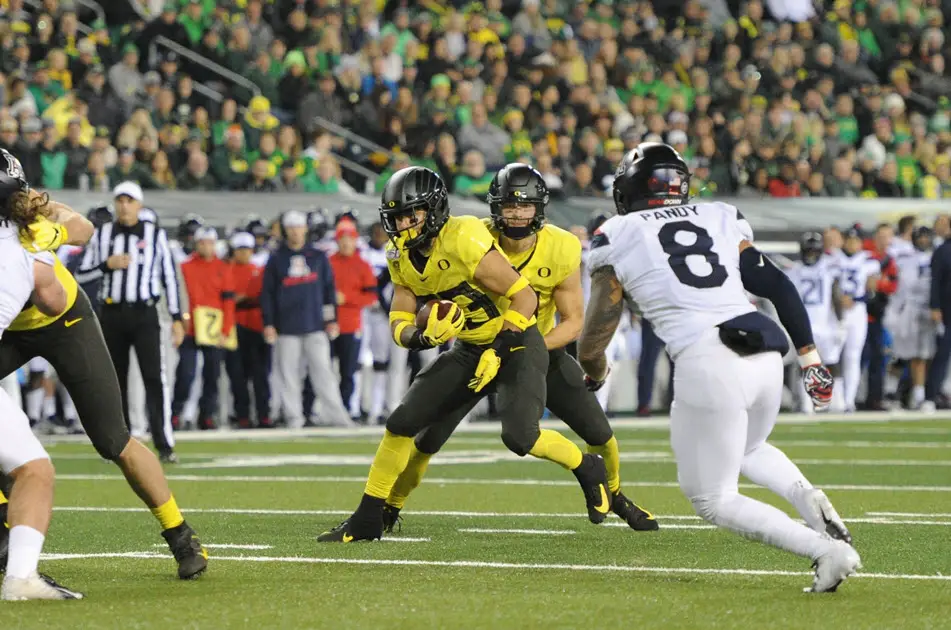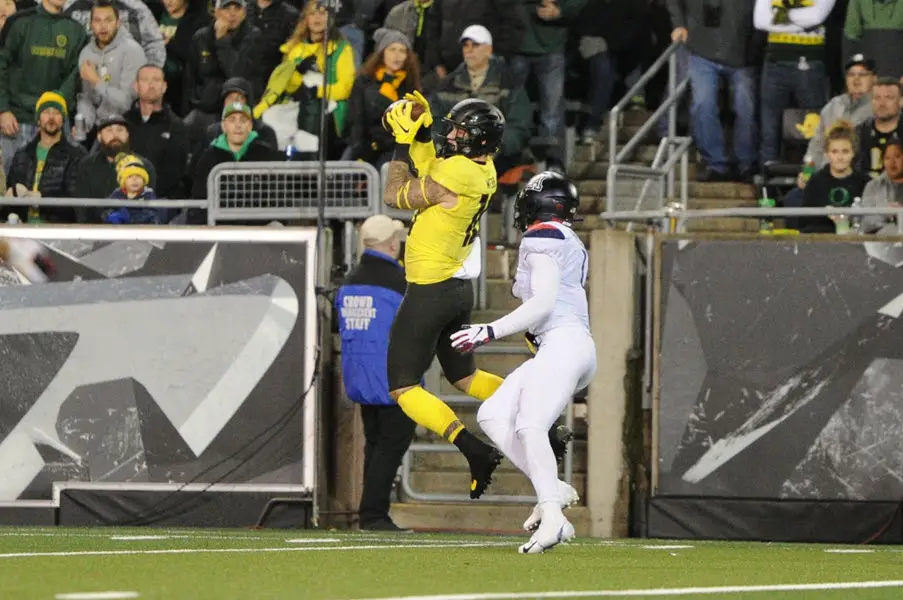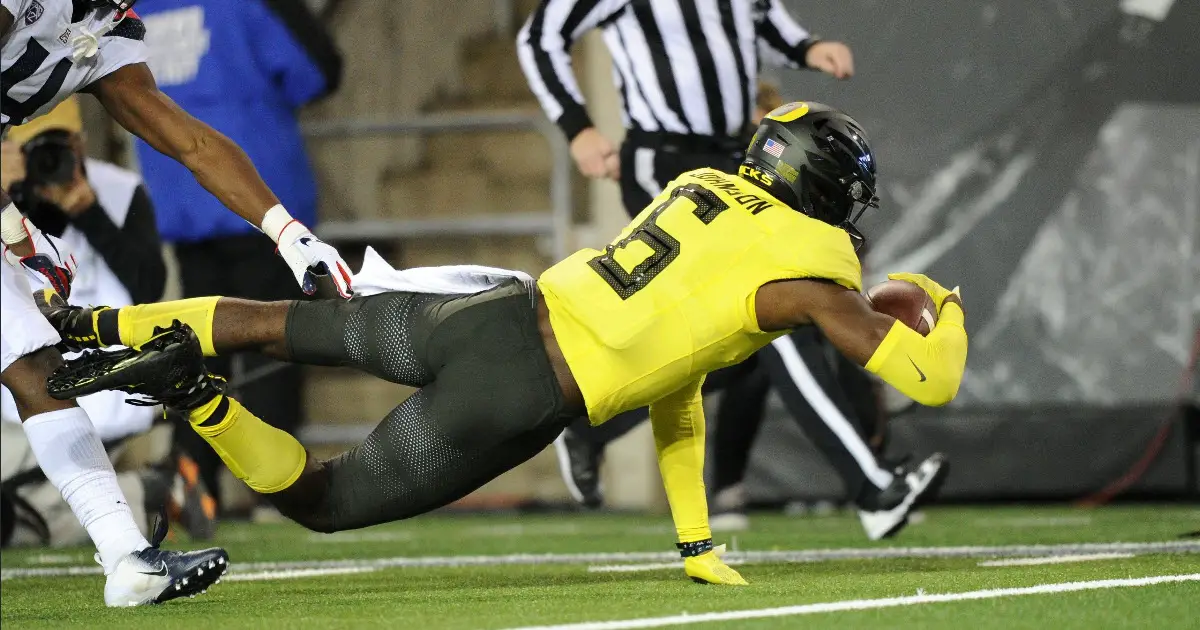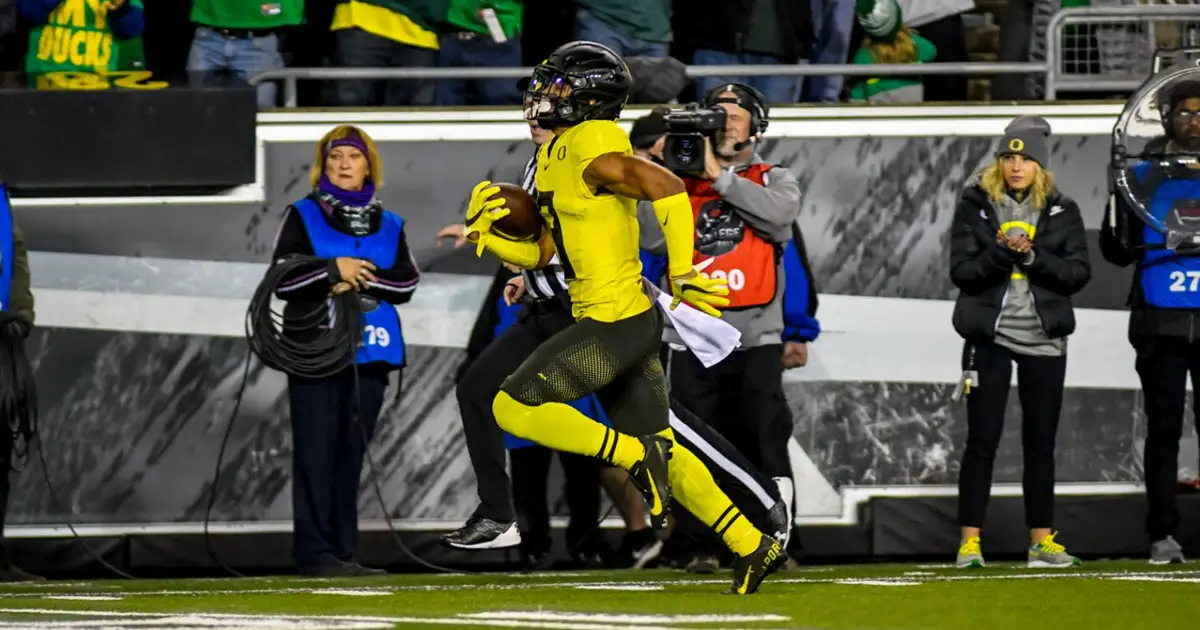The Arizona Wildcats have a bad defense. They came in to this past Saturday giving up an average of over 37 points per game, good for 126th out of 130 FBS teams. The Oregon offense had two weeks to prepare for Arizona and was averaging over 38 points per game coming in to their match-up with the Wildcats.
The Ducks scored 34 points while scoring on one of only two trips to the red zone. By all accounts, that is a less-than-impressive showing, right?
Wrong.
Marcus Arroyo called one of the best games of his Oregon career, and the game would have been much closer with a different game plan.
The First Half

Cyrus Habibi-Likio has seven touchdowns in 2019.
The first drive of the game essentially took as long as it took for J0hnny Johnson III to run 73 yards.
That’s a bit of an exaggeration, the drive was only two plays long, and the first one was a run that got Oregon two yards. The drive opened the game with an Oregon score, giving the Ducks an advantage they would not relinquish for the remainder of the game. The second drive went on to result in a third down drop by Mycah Pittman, but the play call was clearly the correct one.
The Ducks’ third drive was the proverbial “back breaker” during which Oregon ran 13 plays over 6:01 of game time, and ended the drive with a score on the goal line. The play calling on this drive was excellent with three third down conversions, one going for a touchdown.
The next scoring drive was a vintage Ducks drive. Oregon ran seven plays, gained 80 yards and put the game out of reach. This series contained the play of the game, a flea flicker where Justin Herbert hit a well-covered Juwan Johnson for a 47-yard touchdown. Mario Cristobal joked after the game that he practices the play all the time — only he said that the practicing happens with his kids in his backyard.
After a well-called first half, the Ducks led 21-6 with two touchdowns of over 45 yards, despite the worst performance by the offensive line all season.
Second Half

Spencer Webb is carving out a large role in the passing game.
The first score of the second half didn’t occur until there was 7:32 remaining in the third quarter. Oregon had run the ball on four of their first six plays of the half, gently lulling the Arizona defense to sleep before taking a shot at the endzone. The double fake (one a swing pass out of the backfield, and one to Johnson on a screen) to Spencer Webb caught the defense sleeping as Webb bulldozed into the endzone.
The final score of the game was a screen pass to Travis Dye in the fourth quarter. The pass was called after a game’s worth of pressure had resulted in three sacks and several hits on Herbert. The touchdown ended any discussion of Arizona mounting a comeback and gave the Ducks a four score lead.
Overall, the second half saw Oregon possess the ball for just over 16 minutes. The Ducks scored 13 points and focused on running the ball, keeping their drives long and preventing the Wildcat offense from finding any semblance of a rhythm.
Takeaways

The Juwan Johnson score highlighted an open playbook against Arizona.
The Oregon defense is going to get a lot of credit for the win. Racking up a whopping nine sacks while allowing only six points to an offense averaging over 30 points per game warrants some recognition. But without the offensive game plan, this would have been a far closer game.
Oregon’s offense kept Arizona off balance by staying on the field for extended periods of time. The Ducks could have scored more, but this would have forced their opposition to throw the ball more in order to keep up, an issue abundant in the old Oregon offense.
The offense under Chip Kelly and Mark Helfrich saw the ducks score so quickly and often that almost every game felt like a blowout. A great example of this was the 2016 Alamo Bowl, which saw Oregon ahead by so much at halftime that the team took their foot off the gas. The resulting loss was embarrassing, and indicative of other issues, but it highlighted the flaw of the “score as quickly as possible” mantra of the old Oregon brand.
Overall, this win was constructed using fantastic defense and timely offense — a concept that Oregon fans will have to remember from before the glory days. Don’t let the fact that Oregon didn’t score on par with the other offenses Arizona had faced bring down the pleasure of beating an opponent that is often a thorn in the team’s side.
The Ducks haven’t been held under 30 points since October 10th; they’re heading to the conference championship for the first time in five years, and the offense is scoring at a top-15 rate. It sounds like Arroyo has found his groove.
Let’s hope he stays in it.
Ryan Robertson
Yuma, ArizonaTop Photo by Craig Strobeck

Chris Brouilette, the FishDuck.com Volunteer editor for this article, is a current student at the University of Oregon from Sterling, Illinois.
Related Articles:
Oregon Enters Playoffs Better Off Than Last Year
Will The Coaching Carousel Kill Oregon's CFP Chances?
The Playoff Formula Hasn't Changed
Oregon Aims to Bury Dawgs, Punch Playoff Ticket in Rivalry Clash
Huskies Are the New Beavers, Stay In Your Lane Kiffin, and the Civil Apple Cup War
Oregon Football: The X-Factor Vs. Washington
Ryan Robertson is a defense contractor for the United States Marine Corps. A lifelong Duck fan from Grants Pass, he joined the Army out of high school. After four years as an Intelligence Analyst he decided it was time to further his education and pay more attention to his Ducks. One of Ryan’s first memories is of watching the Ducks, led by Joey Harrington, beating up on the Utah Utes in 2001. His grandfather ran track at Oregon in the ‘50s. He loves the Ducks, and has a passionate interest in reading every scrap of analysis centered around the football team.

